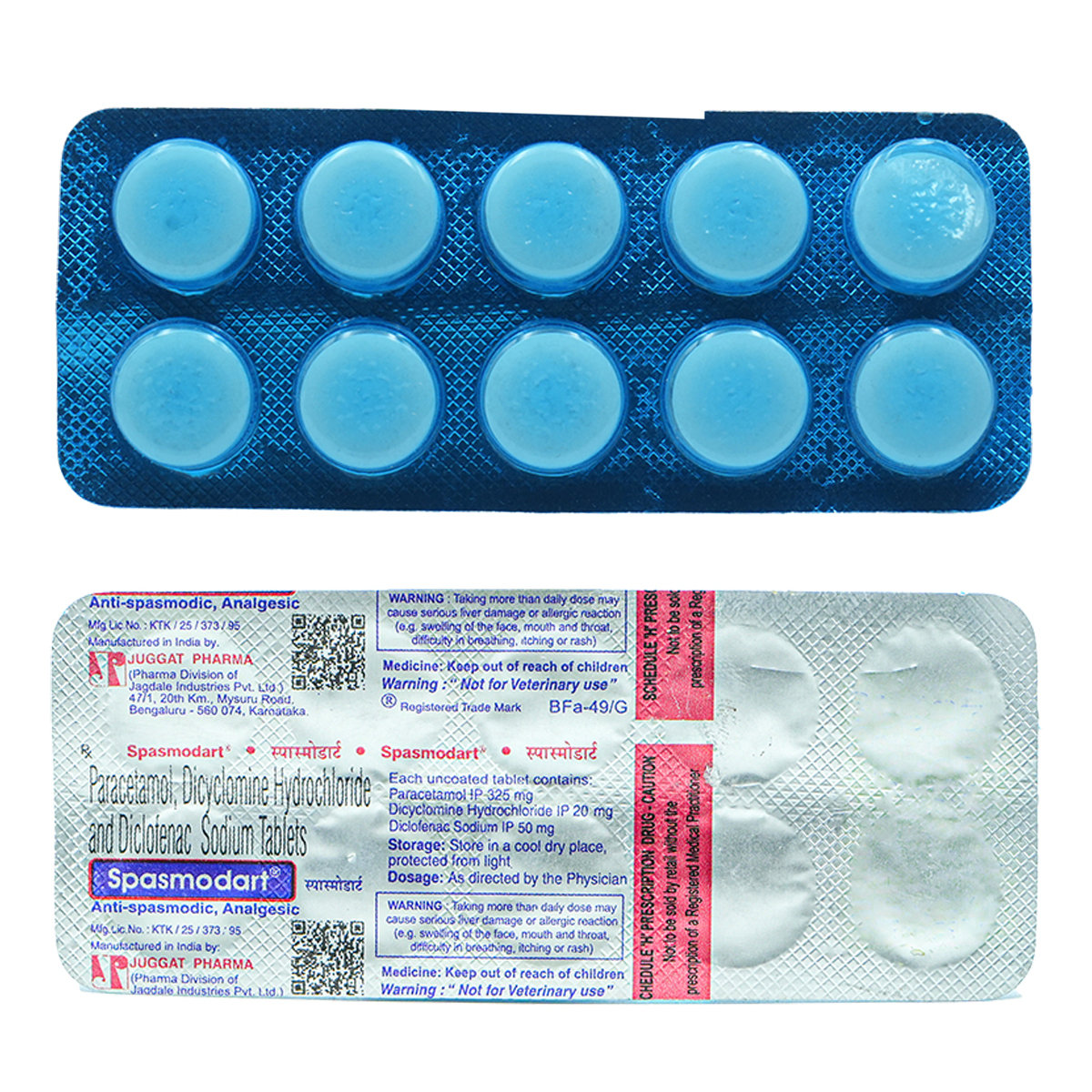Diclofenac+dicyclomine+paracetamol
About Diclofenac+dicyclomine+paracetamol
Diclofenac+dicyclomine+paracetamol is a combination medicine used to relieve pain and discomfort associated with intestinal colic, biliary colic, renal colic and spasmodic dysmenorrhoea (menstrual cramps). Additionally, Diclofenac+dicyclomine+paracetamol is also used to reduce pain and inflammation associated with osteoarthritis, rheumatoid arthritis, ankylosing spondylitis, backache, strain, and sprain.
Diclofenac+dicyclomine+paracetamol is a combination of three drugs, namely: Diclofenac, Paracetamol and Dicyclomine. Diclofenac and Paracetamol work by blocking the effect of chemical messengers that cause pain and inflammation at the injured or damaged site. Dicyclomine works by relieving contractions associated with the smooth muscles of the abdomen. Together, Diclofenac+dicyclomine+paracetamol helps in providing relief from pain.
You are advised to take Diclofenac+dicyclomine+paracetamol for as long as your doctor has prescribed it for you, depending on your medical condition. In some cases, Diclofenac+dicyclomine+paracetamol may cause common side-effects such as nausea, vomiting, heartburn, dizziness, and diarrhoea. Most of these side-effects do not require medical attention and will resolve gradually over time. However, you are advised to talk to your doctor if you experience these side-effects persistently.
Consult your doctor if you are pregnant or breastfeeding. Diclofenac+dicyclomine+paracetamol may cause dizziness, so drive with caution. Diclofenac+dicyclomine+paracetamol should not be given to children as safety and efficacy have not been established. Avoid consuming alcohol with Diclofenac+dicyclomine+paracetamol as it could lead to increased dizziness; it might also increase the risk of stomach bleeding. Keep your doctor informed about your health condition and medicines to rule out any side-effects.
Uses of Diclofenac+dicyclomine+paracetamol
Medicinal Benefits
Diclofenac+dicyclomine+paracetamol is a combination of three drugs, namely: Diclofenac (NSAID), Paracetamol (Analgesic) and Dicyclomine (Anti-cholinergic). Diclofenac+dicyclomine+paracetamol is used to relieve pain and discomfort associated with intestinal colic, biliary colic, renal colic and spasmodic dysmenorrhoea (menstrual cramps). Additionally, Diclofenac+dicyclomine+paracetamol is also used to reduce pain and inflammation associated with osteoarthritis, rheumatoid arthritis, ankylosing spondylitis, backache, strain, and sprain. Diclofenac and Paracetamol work by blocking the effect of chemical messengers known as cyclo-oxygenase (COX) enzymes that make other chemical prostaglandins which are produced at injury sites and cause pain and swelling. By blocking the effect of COX enzymes, lesser prostaglandins are produced, which reduces mild to moderate pain and inflammation at the injured or damaged site. Dicyclomine works by relieving contractions associated with the smooth muscles of the abdomen. Together, Diclofenac+dicyclomine+paracetamol helps in providing relief from abdominal spasms.
Directions for Use
Storage
Side Effects of Diclofenac+dicyclomine+paracetamol
- Nausea
- Vomiting
- Diarrhoea
- Heartburn
- Dizziness
Drug Warnings
Do not take Diclofenac+dicyclomine+paracetamol if you are allergic to any of its contents; if you have/had severe heart problems, stomach ulcer or perforation, and bleeding problems such as bleeding from the stomach. Inform your doctor if you have/had high blood pressure, heart problems, high cholesterol, diabetes, asthma, bypass surgery, heart attack, blood circulation problems, inflammation of intestines, liver or kidney problems. Consult your doctor if you are pregnant or breastfeeding. Diclofenac+dicyclomine+paracetamol may cause dizziness, so drive only if you are alert. Diclofenac+dicyclomine+paracetamol is not recommended for children as safety and effectiveness have not been established. Avoid consuming alcohol along with Diclofenac+dicyclomine+paracetamol as it could lead to increased dizziness and can increase the risk of stomach bleeding. Stop taking Diclofenac+dicyclomine+paracetamol and consult your doctor immediately if you have stomach pain or any signs of bleeding in the intestine or stomach, such as blood in stools. Do not take any other NSAIDs for pain relief along with Diclofenac+dicyclomine+paracetamol unless prescribed.
Drug Interactions
Drug-Drug Interactions: Diclofenac+dicyclomine+paracetamol may interact with an antihistamine (diphenhydramine), anti-hypertensive (metoprolol), pain killers (aspirin, hydrocodone), and anti-depressant (duloxetine).
Drug-Food Interactions: No interactions found/established.
Drug-Disease Interactions: Inform your doctor if you have stomach ulcer or perforation, bleeding problems, heart attack, blood circulation problems, asthma, fluid retention, thrombosis, porphyria, anaemia, high blood pressure, kidney or liver problems.
Drug-Drug Interactions Checker List:
Safety Advice

Alcohol
unsafeAvoid consumption of alcohol while taking Diclofenac+dicyclomine+paracetamol as it may increase dizziness. It can also increase the risk of stomach bleeding.

Pregnancy
cautionPlease consult your doctor if you are pregnant; your doctor will prescribe only if the benefits outweigh the risks.

Breast Feeding
cautionConsult your doctor before taking Diclofenac+dicyclomine+paracetamol; your doctor will decide whether Diclofenac+dicyclomine+paracetamol can be taken by breastfeeding mothers or not.

Driving
cautionDiclofenac+dicyclomine+paracetamol may cause dizziness. Do not drive or operate machinery unless you are alert.

Liver
cautionDose adjustment may be needed in patients with liver impairment. Please consult your doctor if you have a liver impairment or any concerns regarding this.

Kidney
cautionDose adjustment may be needed in patients with kidney impairment. Please consult your doctor if you have kidney impairment or any concerns regarding this.

Children
unsafeDiclofenac+dicyclomine+paracetamol should not be given to children as the safety and effectiveness were not established.
Habit Forming
Diet & Lifestyle Advise
- Exercising regularly helps in muscle stretching so that they are less likely to spasm, tear and sprain. Mild exercises such as jogging and walking are helpful for muscle stretching.
- Massages can also be helpful.
- Avoid freezing and hot temperatures.
- Avoid wearing tight-fitting clothes; instead, wear loose garments.
- Rest well, and get plenty of sleep.
- To avoid developing pressure sores, change your position every two hours.
- Hot or cold therapy can help treat muscle spasms. Apply an ice-pack or hot-pack on the muscle for 15-20minutes.
- Stay hydrated, drink plenty of water.
Patients Concern
Disease/Condition Glossary
Abdominal pain and cramps: Abdominal pain occurs between the chest and pelvic region, generally known as stomach or tummy pain. Pain is a symptom triggered by the nervous system, causing uncomfortable sensations in the body. Muscle spasm is the sudden involuntary contractions of the muscle, which can be painful and uncomfortable. When the nerve impulses that control the muscle movements are damaged or interrupted, it could lead to muscle spasms. The common causes of abdominal pain include inflammation, infections, intestinal disorders and obstruction/blockage. Abdominal pain could be generalised, localised, cramps or colicky pain.
Musculoskeletal pain: Musculoskeletal pain affects the bones, muscles, ligaments, tendons, and nerves. It could occur due to arthritis, osteoporosis, fractures, dislocations, problems with the bone structure or injury to the bones, joints, tendons, muscles and ligaments. Symptoms of musculoskeletal pain include stiffness, swelling, redness, weakness, muscle spasms or twitching, trouble moving the affected area, and soreness.
FAQs
Diclofenac+dicyclomine+paracetamol contains Diclofenac, Paracetamol and Dicyclomine. Diclofenac and Paracetamol work by blocking the effect of chemical messengers that cause inflammation at the injured or damaged site. Dicyclomine works by relieving contractions associated with the smooth muscles of the abdomen. Together, Diclofenac+dicyclomine+paracetamol helps in providing relief from pain.
Diarrhoea might be a side-effect of Diclofenac+dicyclomine+paracetamol. Drink enough fluids and eat non-spicy food if you experience diarrhoea. Consult your doctor if you experience severe diarrhoea or if you find blood in stools.
Do not take any other pain killer medicines along with Diclofenac+dicyclomine+paracetamol unless prescribed as it might lead to unpleasant side-effects and can increase the risk of stomach bleeding associated with NSAIDs.
Dry mouth could be a side-effect of Diclofenac+dicyclomine+paracetamol. Limiting caffeine intake, avoiding smoking and mouthwashes containing alcohol, drinking water regularly and chewing sugar-free gum/candy might help in stimulating saliva and thereby prevents drying of the mouth.
Diclofenac+dicyclomine+paracetamol should be taken for longer durations only if prescribed by the doctor. Avoid taking Diclofenac+dicyclomine+paracetamol for longer durations as it might increase the risk of heart problems and stomach bleeding.
Diclofenac+dicyclomine+paracetamol may be used to treat dysmenorrhea (period pain), pain due to heavy bleeding during periods and menstrual cramps. Take Diclofenac+dicyclomine+paracetamol only as prescribed, and do not overdose.




